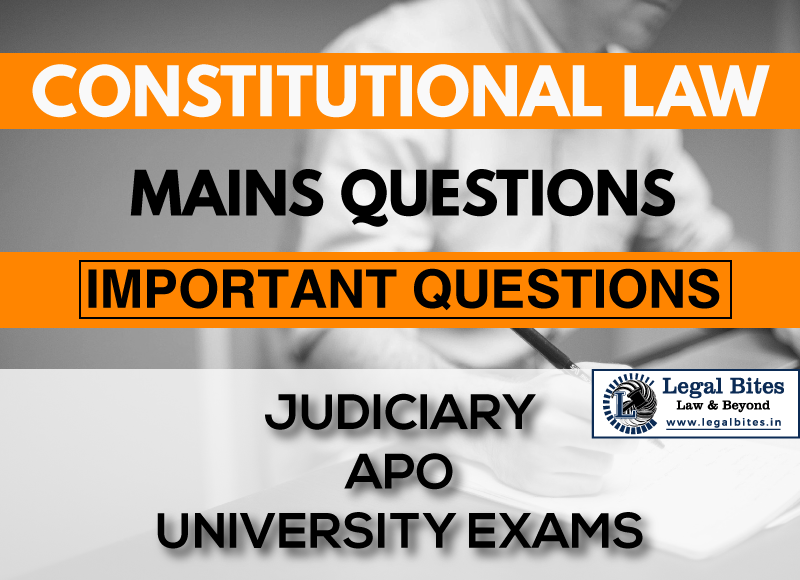State the procedure according to which the Constitution of India can be amended. Can the Constitution be so amended as to destroy its basic features? Explain with reference to the view of the Supreme Court.
Question: State the procedure according to which the Constitution of India can be amended. Can the Constitution be so amended as to destroy its basic features? Explain with reference to the view of the Supreme Court. [BJS 1986] Find the answer to the mains question only on Legal Bites. [State the procedure according to which the Constitution of… Read More »

Question: State the procedure according to which the Constitution of India can be amended. Can the Constitution be so amended as to destroy its basic features? Explain with reference to the view of the Supreme Court. [BJS 1986] Find the answer to the mains question only on Legal Bites. [State the procedure according to which the Constitution of India can be amended. Can the Constitution be so amended as to destroy its basic features? Explain with reference to the view of the...
Question: State the procedure according to which the Constitution of India can be amended. Can the Constitution be so amended as to destroy its basic features? Explain with reference to the view of the Supreme Court. [BJS 1986]
Find the answer to the mains question only on Legal Bites. [State the procedure according to which the Constitution of India can be amended. Can the Constitution be so amended as to destroy its basic features? Explain with reference to the view of the Supreme Court.]
Answer
The Constitution of India provides for its amendment in order to adjust itself to the changing conditions and needs. Article 368 in Part XX of the Constitution deals with the powers of Parliament to amend the Constitution and its procedure.
The procedure for the amendment of the Constitution as laid down under Article 368 is as follows:
- An amendment of the Constitution can be initiated only by the introduction of a bill for the purpose in either House of Parliament and not in the state legislatures.
- The bill can be introduced either by a minister or by a private member and does not require prior permission from the president.
- The bill must be passed in each House by a special majority, that is, a majority of the total membership of the House and a majority of two-thirds of the members of the House present and voting.
- Each House must pass the bill separately. In case of a disagreement between the two Houses, there is no provision for holding a joint sitting of the two Houses for the purpose of deliberation and passage of the bill.
- If the bill seeks to amend the federal provisions of the Constitution, it must also be ratified by the legislatures of half of the states by a simple majority.
- After duly passed by both the Houses of Parliament and ratified by the state legislatures, where necessary, the bill is presented to the President for assent.
- The President must give his assent to the bill. He can neither withhold his assent to the bill nor return the bill to the Parliament for reconsideration.
- After the President’s assent, the bill becomes an Act (i.e., a Constitutional Amendment Act) and the Constitution stands amended in accordance with the terms of the Act.
Following the 24th Amendment Act, 1971, a new clause (4) was added to Article 13 which says that ‘nothing in this article shall apply to any amendment of this Constitution made under Article 368.’ This means the basic structure of the constitution cannot be taken away or amended by any law passed by the Parliament.
This was decided in the Kesavananda Bharati v. State of Kerala [(1973) 4 SCC 22] case, in which the Supreme Court declared that Article 368 did not enable Parliament to alter the basic structure or framework of the Constitution and parliament could not use its amending powers under Article 368 to ‘damage’, ’emasculate’, ‘destroy’, ‘abrogate’, ‘change’ or ‘alter’ the ‘basic structure’ or framework of the constitution. This decision is not just a landmark in the evolution of constitutional law, but a turning point in constitutional history because it overruled the earlier decision which granted the Parliament with excessive power to even bring an amendment that would have an effect on the basic structure of the constitution.
Important Mains Questions Series for Judiciary, APO & University Exams
- Constitutional Law Mains Questions Series Part-I
- Constitutional Law Mains Questions Series Part-I
- Constitutional Law Mains Questions Series Part-II
- Constitutional Law Mains Questions Series Part-IV
- Constitutional Law Mains Questions Series Part-V
- Constitutional Law Mains Questions Series Part-VI
- Constitutional Law Mains Questions Series Part-VII
- Constitutional Law Mains Questions Series Part-VIII
- Constitutional Law Mains Questions Series Part-IX
- Constitutional Law Mains Questions Series Part-X
Admin Legal Bites
Legal Bites Study Materials correspond to what is taught in law schools and what is tested in competitive exams. It pledges to offer a competitive advantage, prepare for tests, and save a lot of money.
